Employee Turnover Issues at the Workplace and Business Impact
VerifiedAdded on 2022/10/06
|13
|3165
|9
Report
AI Summary
This report delves into the critical issue of employee turnover within the workplace and its significant impact on business growth. It begins with an introduction to the concept of employee turnover, defining it as the departure of employees within a specific timeframe and exploring the various factors that contribute to this phenomenon, such as lack of recognition, conflicts, unfulfilled expectations, and job dissatisfaction. The report emphasizes the necessity of business growth in today's competitive market and then meticulously examines the negative consequences of employee turnover, including compromised performance and increased financial burdens. Furthermore, the report provides an overview of the techniques that can be employed to reduce employee turnover rates, such as fostering employee motivation, recognizing and appreciating employee contributions, and improving communication. The report concludes by summarizing the key findings and reinforcing the crucial role of employees in business success and growth. It highlights the importance of addressing employee issues to mitigate turnover and ensure sustained business performance.
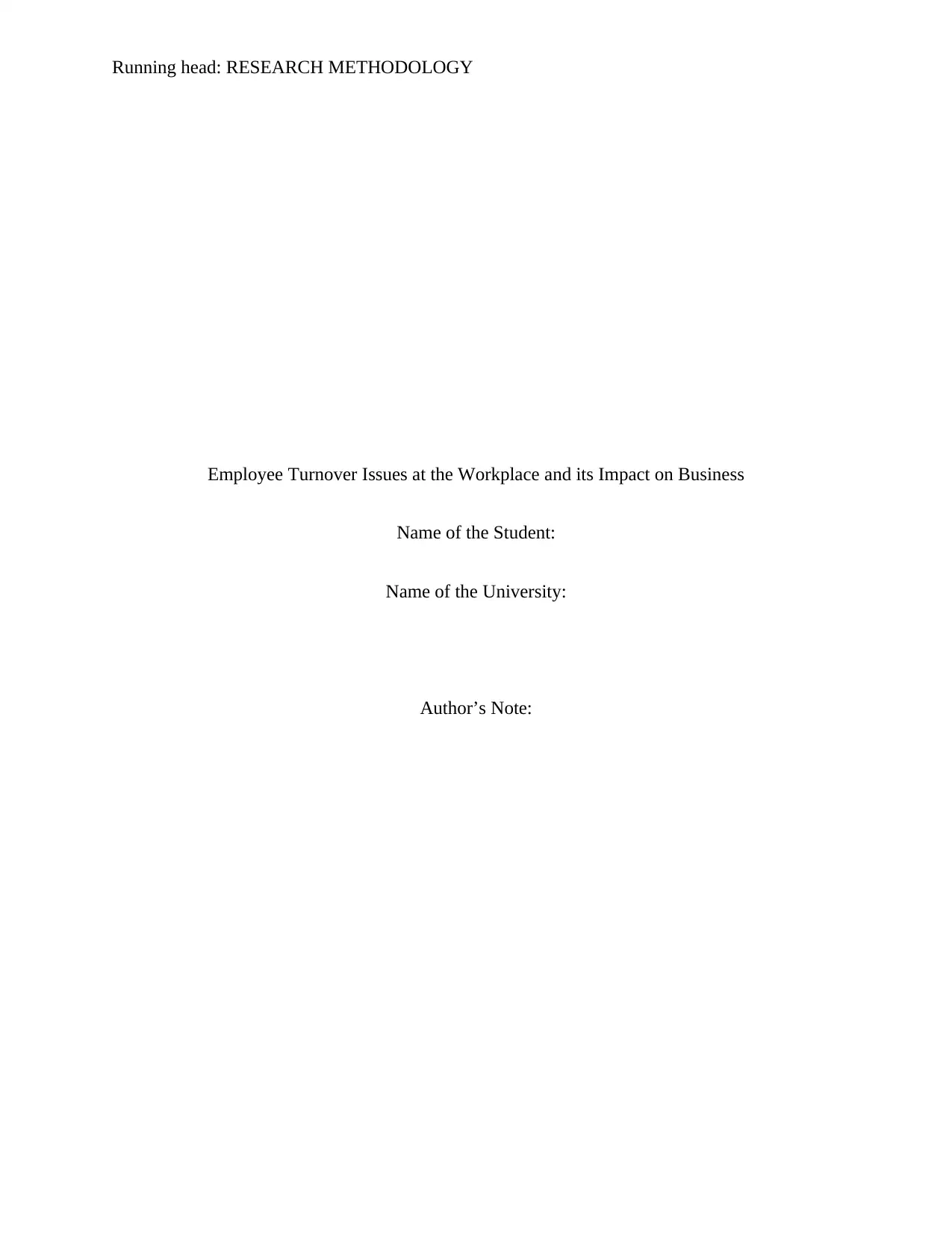
Running head: RESEARCH METHODOLOGY
Employee Turnover Issues at the Workplace and its Impact on Business
Name of the Student:
Name of the University:
Author’s Note:
Employee Turnover Issues at the Workplace and its Impact on Business
Name of the Student:
Name of the University:
Author’s Note:
Paraphrase This Document
Need a fresh take? Get an instant paraphrase of this document with our AI Paraphraser
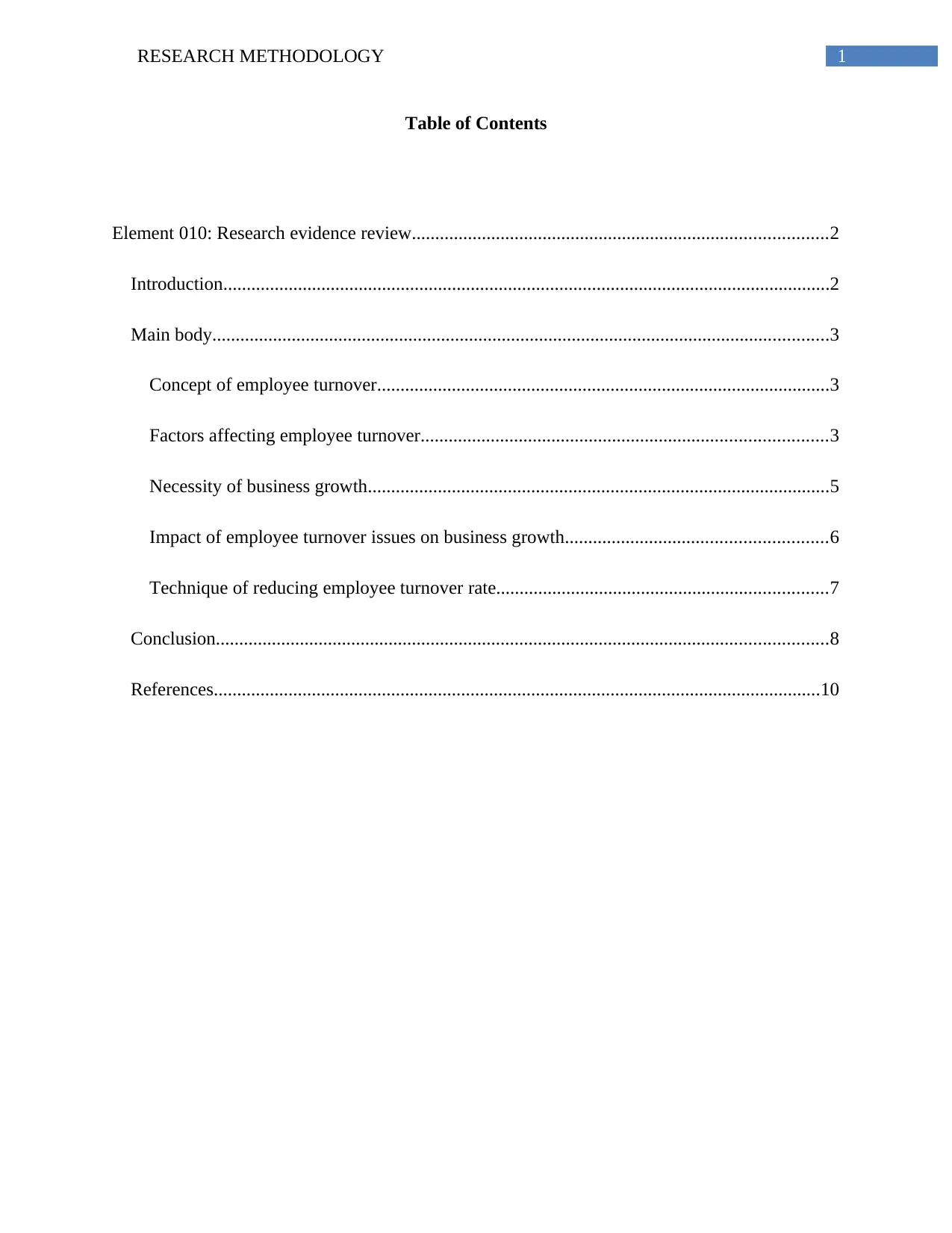
1RESEARCH METHODOLOGY
Table of Contents
Element 010: Research evidence review.........................................................................................2
Introduction..................................................................................................................................2
Main body....................................................................................................................................3
Concept of employee turnover.................................................................................................3
Factors affecting employee turnover.......................................................................................3
Necessity of business growth...................................................................................................5
Impact of employee turnover issues on business growth........................................................6
Technique of reducing employee turnover rate.......................................................................7
Conclusion...................................................................................................................................8
References..................................................................................................................................10
Table of Contents
Element 010: Research evidence review.........................................................................................2
Introduction..................................................................................................................................2
Main body....................................................................................................................................3
Concept of employee turnover.................................................................................................3
Factors affecting employee turnover.......................................................................................3
Necessity of business growth...................................................................................................5
Impact of employee turnover issues on business growth........................................................6
Technique of reducing employee turnover rate.......................................................................7
Conclusion...................................................................................................................................8
References..................................................................................................................................10
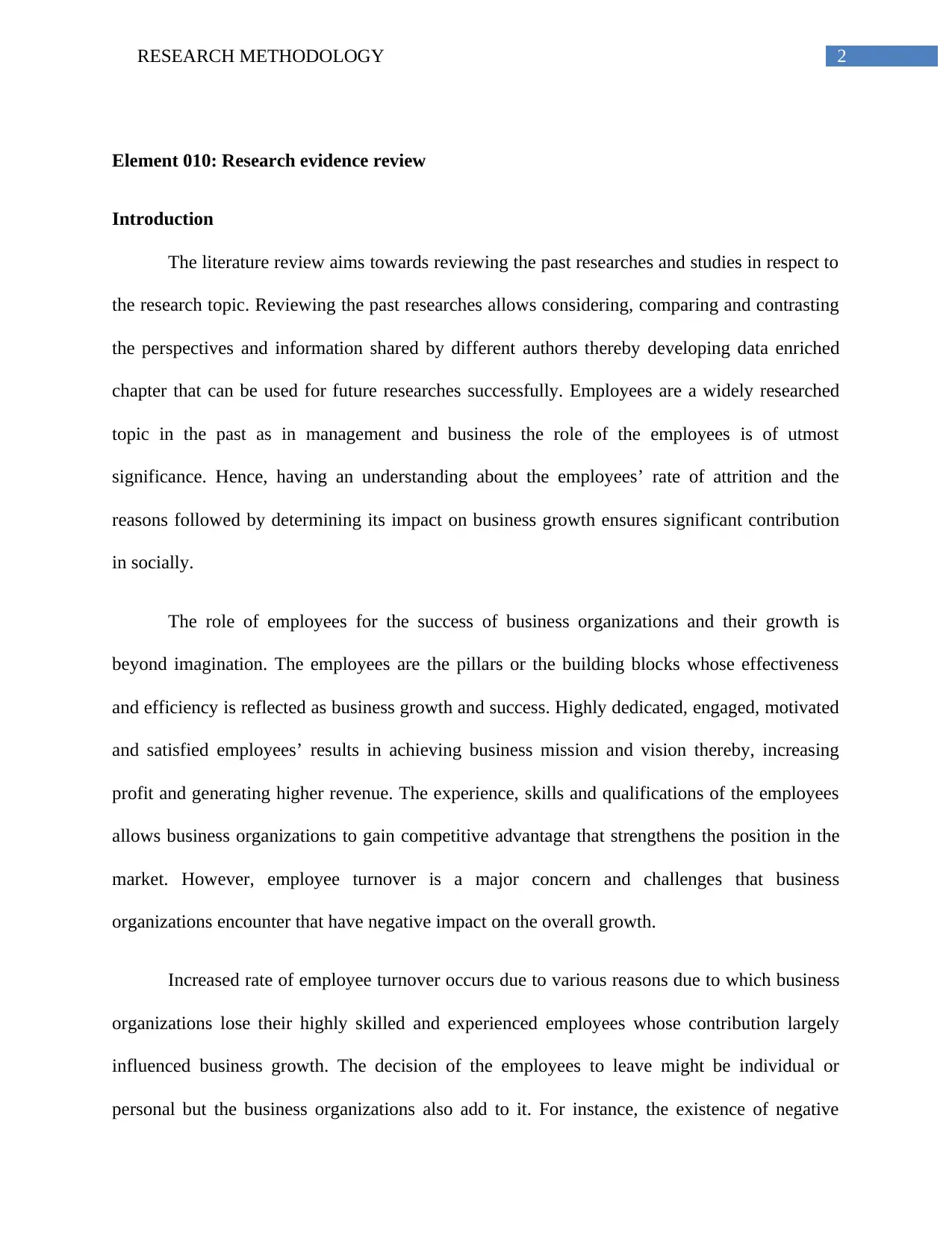
2RESEARCH METHODOLOGY
Element 010: Research evidence review
Introduction
The literature review aims towards reviewing the past researches and studies in respect to
the research topic. Reviewing the past researches allows considering, comparing and contrasting
the perspectives and information shared by different authors thereby developing data enriched
chapter that can be used for future researches successfully. Employees are a widely researched
topic in the past as in management and business the role of the employees is of utmost
significance. Hence, having an understanding about the employees’ rate of attrition and the
reasons followed by determining its impact on business growth ensures significant contribution
in socially.
The role of employees for the success of business organizations and their growth is
beyond imagination. The employees are the pillars or the building blocks whose effectiveness
and efficiency is reflected as business growth and success. Highly dedicated, engaged, motivated
and satisfied employees’ results in achieving business mission and vision thereby, increasing
profit and generating higher revenue. The experience, skills and qualifications of the employees
allows business organizations to gain competitive advantage that strengthens the position in the
market. However, employee turnover is a major concern and challenges that business
organizations encounter that have negative impact on the overall growth.
Increased rate of employee turnover occurs due to various reasons due to which business
organizations lose their highly skilled and experienced employees whose contribution largely
influenced business growth. The decision of the employees to leave might be individual or
personal but the business organizations also add to it. For instance, the existence of negative
Element 010: Research evidence review
Introduction
The literature review aims towards reviewing the past researches and studies in respect to
the research topic. Reviewing the past researches allows considering, comparing and contrasting
the perspectives and information shared by different authors thereby developing data enriched
chapter that can be used for future researches successfully. Employees are a widely researched
topic in the past as in management and business the role of the employees is of utmost
significance. Hence, having an understanding about the employees’ rate of attrition and the
reasons followed by determining its impact on business growth ensures significant contribution
in socially.
The role of employees for the success of business organizations and their growth is
beyond imagination. The employees are the pillars or the building blocks whose effectiveness
and efficiency is reflected as business growth and success. Highly dedicated, engaged, motivated
and satisfied employees’ results in achieving business mission and vision thereby, increasing
profit and generating higher revenue. The experience, skills and qualifications of the employees
allows business organizations to gain competitive advantage that strengthens the position in the
market. However, employee turnover is a major concern and challenges that business
organizations encounter that have negative impact on the overall growth.
Increased rate of employee turnover occurs due to various reasons due to which business
organizations lose their highly skilled and experienced employees whose contribution largely
influenced business growth. The decision of the employees to leave might be individual or
personal but the business organizations also add to it. For instance, the existence of negative
⊘ This is a preview!⊘
Do you want full access?
Subscribe today to unlock all pages.

Trusted by 1+ million students worldwide
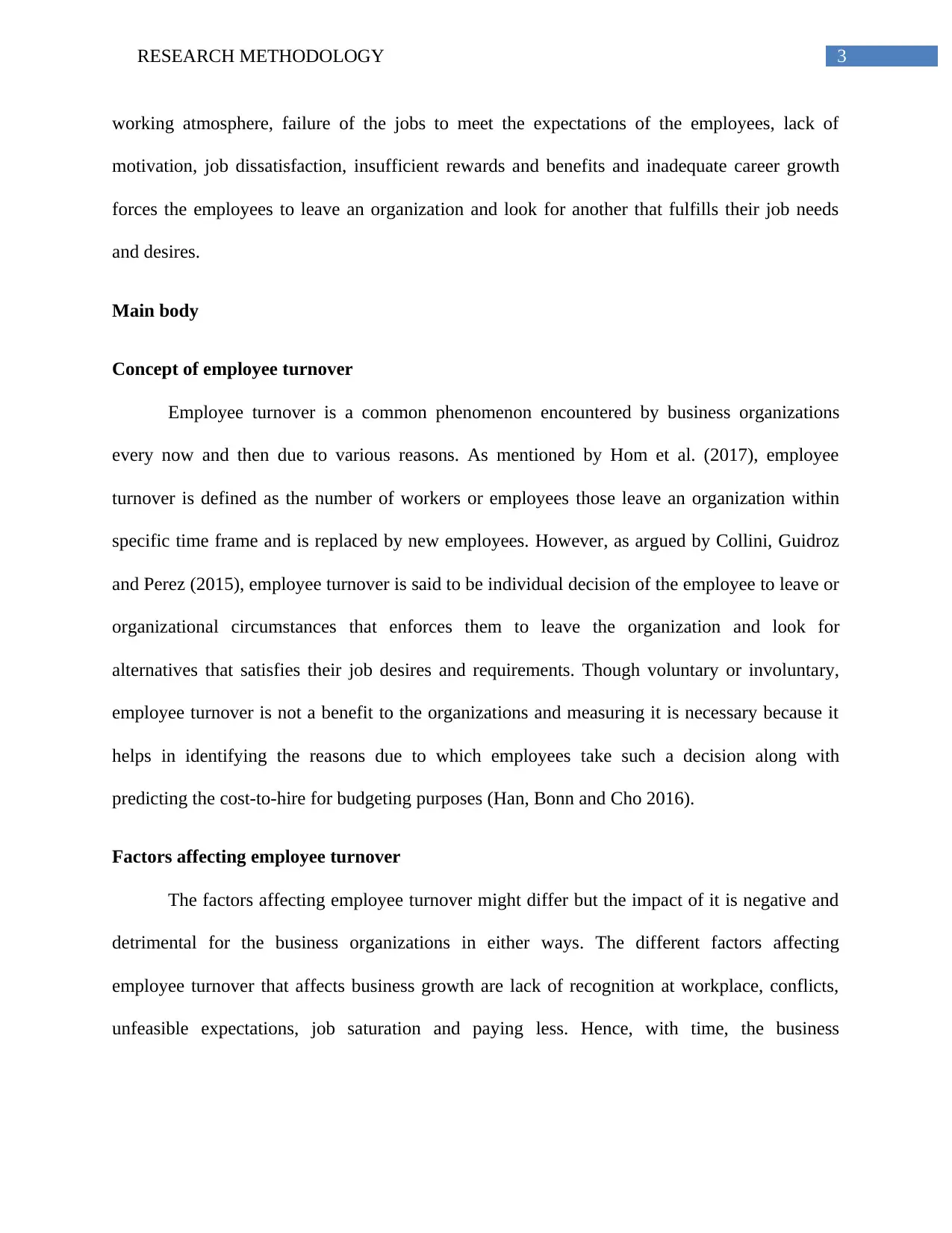
3RESEARCH METHODOLOGY
working atmosphere, failure of the jobs to meet the expectations of the employees, lack of
motivation, job dissatisfaction, insufficient rewards and benefits and inadequate career growth
forces the employees to leave an organization and look for another that fulfills their job needs
and desires.
Main body
Concept of employee turnover
Employee turnover is a common phenomenon encountered by business organizations
every now and then due to various reasons. As mentioned by Hom et al. (2017), employee
turnover is defined as the number of workers or employees those leave an organization within
specific time frame and is replaced by new employees. However, as argued by Collini, Guidroz
and Perez (2015), employee turnover is said to be individual decision of the employee to leave or
organizational circumstances that enforces them to leave the organization and look for
alternatives that satisfies their job desires and requirements. Though voluntary or involuntary,
employee turnover is not a benefit to the organizations and measuring it is necessary because it
helps in identifying the reasons due to which employees take such a decision along with
predicting the cost-to-hire for budgeting purposes (Han, Bonn and Cho 2016).
Factors affecting employee turnover
The factors affecting employee turnover might differ but the impact of it is negative and
detrimental for the business organizations in either ways. The different factors affecting
employee turnover that affects business growth are lack of recognition at workplace, conflicts,
unfeasible expectations, job saturation and paying less. Hence, with time, the business
working atmosphere, failure of the jobs to meet the expectations of the employees, lack of
motivation, job dissatisfaction, insufficient rewards and benefits and inadequate career growth
forces the employees to leave an organization and look for another that fulfills their job needs
and desires.
Main body
Concept of employee turnover
Employee turnover is a common phenomenon encountered by business organizations
every now and then due to various reasons. As mentioned by Hom et al. (2017), employee
turnover is defined as the number of workers or employees those leave an organization within
specific time frame and is replaced by new employees. However, as argued by Collini, Guidroz
and Perez (2015), employee turnover is said to be individual decision of the employee to leave or
organizational circumstances that enforces them to leave the organization and look for
alternatives that satisfies their job desires and requirements. Though voluntary or involuntary,
employee turnover is not a benefit to the organizations and measuring it is necessary because it
helps in identifying the reasons due to which employees take such a decision along with
predicting the cost-to-hire for budgeting purposes (Han, Bonn and Cho 2016).
Factors affecting employee turnover
The factors affecting employee turnover might differ but the impact of it is negative and
detrimental for the business organizations in either ways. The different factors affecting
employee turnover that affects business growth are lack of recognition at workplace, conflicts,
unfeasible expectations, job saturation and paying less. Hence, with time, the business
Paraphrase This Document
Need a fresh take? Get an instant paraphrase of this document with our AI Paraphraser
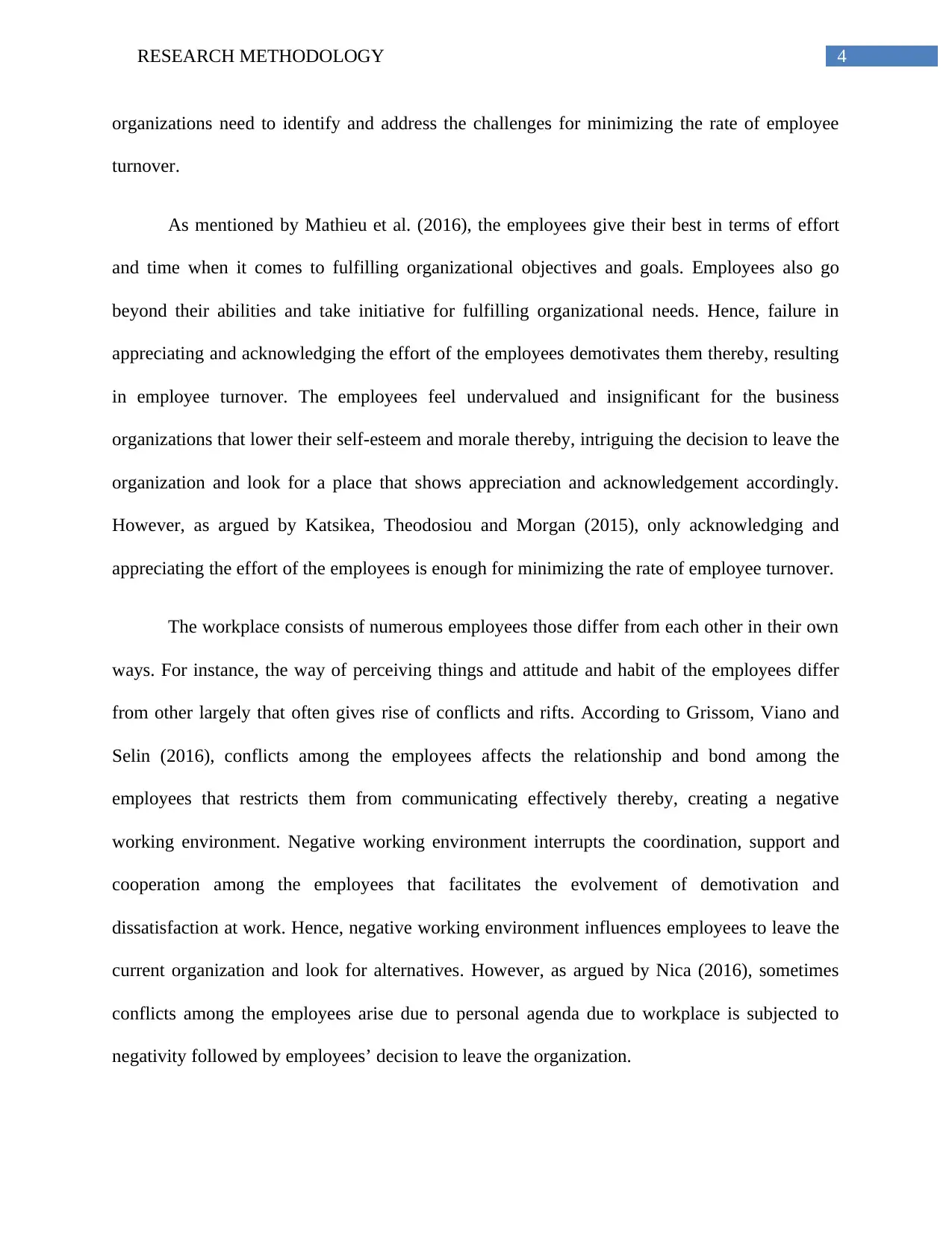
4RESEARCH METHODOLOGY
organizations need to identify and address the challenges for minimizing the rate of employee
turnover.
As mentioned by Mathieu et al. (2016), the employees give their best in terms of effort
and time when it comes to fulfilling organizational objectives and goals. Employees also go
beyond their abilities and take initiative for fulfilling organizational needs. Hence, failure in
appreciating and acknowledging the effort of the employees demotivates them thereby, resulting
in employee turnover. The employees feel undervalued and insignificant for the business
organizations that lower their self-esteem and morale thereby, intriguing the decision to leave the
organization and look for a place that shows appreciation and acknowledgement accordingly.
However, as argued by Katsikea, Theodosiou and Morgan (2015), only acknowledging and
appreciating the effort of the employees is enough for minimizing the rate of employee turnover.
The workplace consists of numerous employees those differ from each other in their own
ways. For instance, the way of perceiving things and attitude and habit of the employees differ
from other largely that often gives rise of conflicts and rifts. According to Grissom, Viano and
Selin (2016), conflicts among the employees affects the relationship and bond among the
employees that restricts them from communicating effectively thereby, creating a negative
working environment. Negative working environment interrupts the coordination, support and
cooperation among the employees that facilitates the evolvement of demotivation and
dissatisfaction at work. Hence, negative working environment influences employees to leave the
current organization and look for alternatives. However, as argued by Nica (2016), sometimes
conflicts among the employees arise due to personal agenda due to workplace is subjected to
negativity followed by employees’ decision to leave the organization.
organizations need to identify and address the challenges for minimizing the rate of employee
turnover.
As mentioned by Mathieu et al. (2016), the employees give their best in terms of effort
and time when it comes to fulfilling organizational objectives and goals. Employees also go
beyond their abilities and take initiative for fulfilling organizational needs. Hence, failure in
appreciating and acknowledging the effort of the employees demotivates them thereby, resulting
in employee turnover. The employees feel undervalued and insignificant for the business
organizations that lower their self-esteem and morale thereby, intriguing the decision to leave the
organization and look for a place that shows appreciation and acknowledgement accordingly.
However, as argued by Katsikea, Theodosiou and Morgan (2015), only acknowledging and
appreciating the effort of the employees is enough for minimizing the rate of employee turnover.
The workplace consists of numerous employees those differ from each other in their own
ways. For instance, the way of perceiving things and attitude and habit of the employees differ
from other largely that often gives rise of conflicts and rifts. According to Grissom, Viano and
Selin (2016), conflicts among the employees affects the relationship and bond among the
employees that restricts them from communicating effectively thereby, creating a negative
working environment. Negative working environment interrupts the coordination, support and
cooperation among the employees that facilitates the evolvement of demotivation and
dissatisfaction at work. Hence, negative working environment influences employees to leave the
current organization and look for alternatives. However, as argued by Nica (2016), sometimes
conflicts among the employees arise due to personal agenda due to workplace is subjected to
negativity followed by employees’ decision to leave the organization.
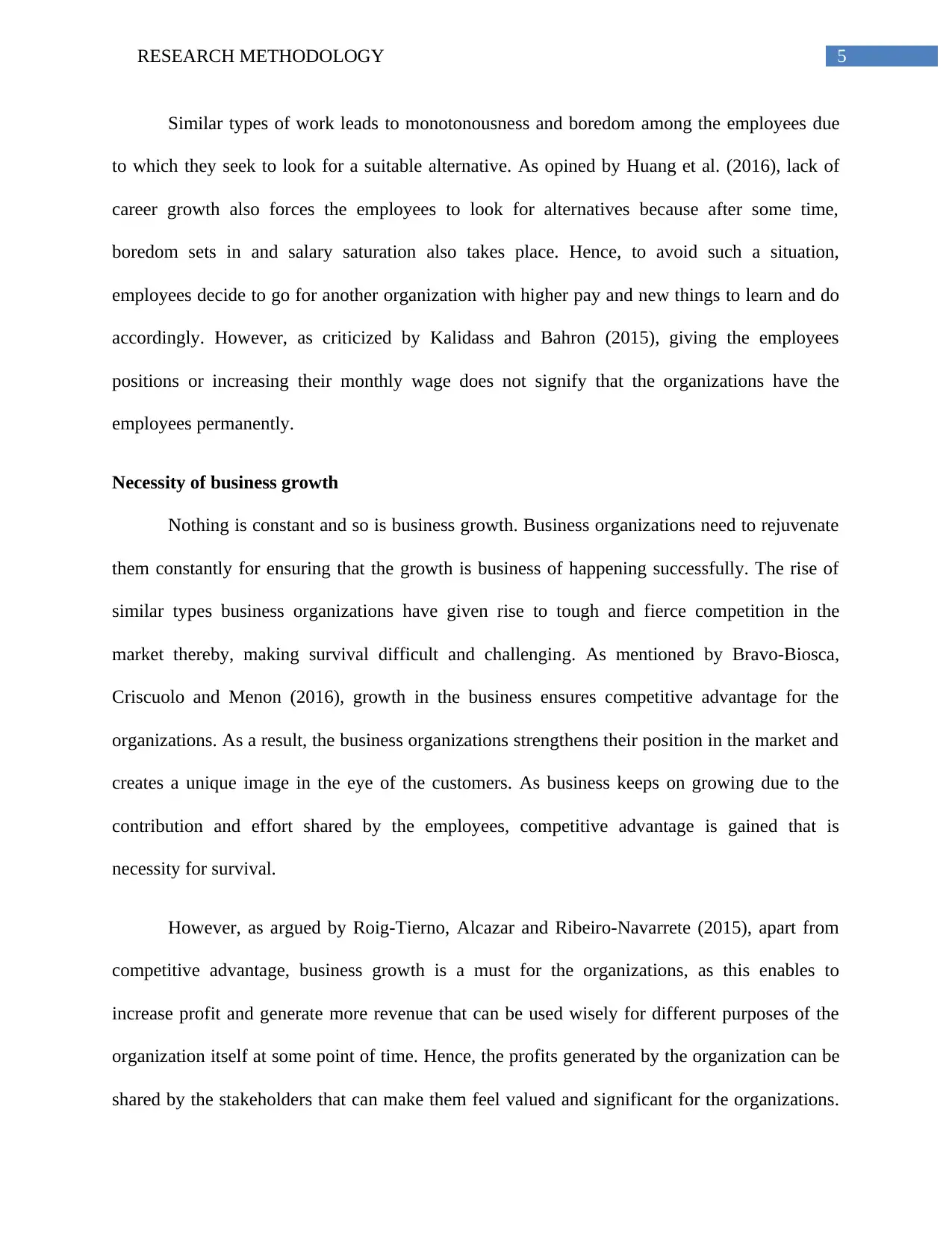
5RESEARCH METHODOLOGY
Similar types of work leads to monotonousness and boredom among the employees due
to which they seek to look for a suitable alternative. As opined by Huang et al. (2016), lack of
career growth also forces the employees to look for alternatives because after some time,
boredom sets in and salary saturation also takes place. Hence, to avoid such a situation,
employees decide to go for another organization with higher pay and new things to learn and do
accordingly. However, as criticized by Kalidass and Bahron (2015), giving the employees
positions or increasing their monthly wage does not signify that the organizations have the
employees permanently.
Necessity of business growth
Nothing is constant and so is business growth. Business organizations need to rejuvenate
them constantly for ensuring that the growth is business of happening successfully. The rise of
similar types business organizations have given rise to tough and fierce competition in the
market thereby, making survival difficult and challenging. As mentioned by Bravo-Biosca,
Criscuolo and Menon (2016), growth in the business ensures competitive advantage for the
organizations. As a result, the business organizations strengthens their position in the market and
creates a unique image in the eye of the customers. As business keeps on growing due to the
contribution and effort shared by the employees, competitive advantage is gained that is
necessity for survival.
However, as argued by Roig-Tierno, Alcazar and Ribeiro-Navarrete (2015), apart from
competitive advantage, business growth is a must for the organizations, as this enables to
increase profit and generate more revenue that can be used wisely for different purposes of the
organization itself at some point of time. Hence, the profits generated by the organization can be
shared by the stakeholders that can make them feel valued and significant for the organizations.
Similar types of work leads to monotonousness and boredom among the employees due
to which they seek to look for a suitable alternative. As opined by Huang et al. (2016), lack of
career growth also forces the employees to look for alternatives because after some time,
boredom sets in and salary saturation also takes place. Hence, to avoid such a situation,
employees decide to go for another organization with higher pay and new things to learn and do
accordingly. However, as criticized by Kalidass and Bahron (2015), giving the employees
positions or increasing their monthly wage does not signify that the organizations have the
employees permanently.
Necessity of business growth
Nothing is constant and so is business growth. Business organizations need to rejuvenate
them constantly for ensuring that the growth is business of happening successfully. The rise of
similar types business organizations have given rise to tough and fierce competition in the
market thereby, making survival difficult and challenging. As mentioned by Bravo-Biosca,
Criscuolo and Menon (2016), growth in the business ensures competitive advantage for the
organizations. As a result, the business organizations strengthens their position in the market and
creates a unique image in the eye of the customers. As business keeps on growing due to the
contribution and effort shared by the employees, competitive advantage is gained that is
necessity for survival.
However, as argued by Roig-Tierno, Alcazar and Ribeiro-Navarrete (2015), apart from
competitive advantage, business growth is a must for the organizations, as this enables to
increase profit and generate more revenue that can be used wisely for different purposes of the
organization itself at some point of time. Hence, the profits generated by the organization can be
shared by the stakeholders that can make them feel valued and significant for the organizations.
⊘ This is a preview!⊘
Do you want full access?
Subscribe today to unlock all pages.

Trusted by 1+ million students worldwide
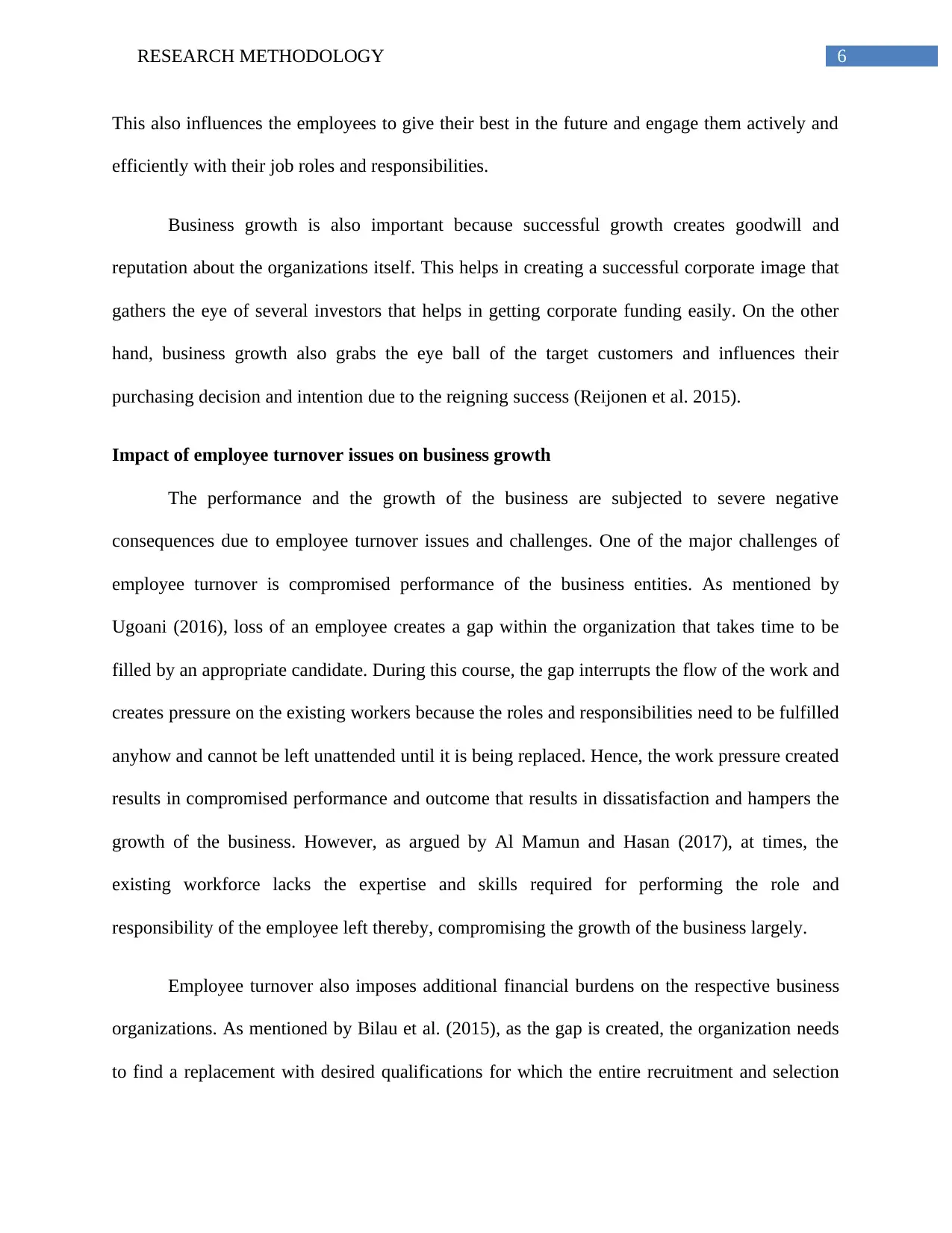
6RESEARCH METHODOLOGY
This also influences the employees to give their best in the future and engage them actively and
efficiently with their job roles and responsibilities.
Business growth is also important because successful growth creates goodwill and
reputation about the organizations itself. This helps in creating a successful corporate image that
gathers the eye of several investors that helps in getting corporate funding easily. On the other
hand, business growth also grabs the eye ball of the target customers and influences their
purchasing decision and intention due to the reigning success (Reijonen et al. 2015).
Impact of employee turnover issues on business growth
The performance and the growth of the business are subjected to severe negative
consequences due to employee turnover issues and challenges. One of the major challenges of
employee turnover is compromised performance of the business entities. As mentioned by
Ugoani (2016), loss of an employee creates a gap within the organization that takes time to be
filled by an appropriate candidate. During this course, the gap interrupts the flow of the work and
creates pressure on the existing workers because the roles and responsibilities need to be fulfilled
anyhow and cannot be left unattended until it is being replaced. Hence, the work pressure created
results in compromised performance and outcome that results in dissatisfaction and hampers the
growth of the business. However, as argued by Al Mamun and Hasan (2017), at times, the
existing workforce lacks the expertise and skills required for performing the role and
responsibility of the employee left thereby, compromising the growth of the business largely.
Employee turnover also imposes additional financial burdens on the respective business
organizations. As mentioned by Bilau et al. (2015), as the gap is created, the organization needs
to find a replacement with desired qualifications for which the entire recruitment and selection
This also influences the employees to give their best in the future and engage them actively and
efficiently with their job roles and responsibilities.
Business growth is also important because successful growth creates goodwill and
reputation about the organizations itself. This helps in creating a successful corporate image that
gathers the eye of several investors that helps in getting corporate funding easily. On the other
hand, business growth also grabs the eye ball of the target customers and influences their
purchasing decision and intention due to the reigning success (Reijonen et al. 2015).
Impact of employee turnover issues on business growth
The performance and the growth of the business are subjected to severe negative
consequences due to employee turnover issues and challenges. One of the major challenges of
employee turnover is compromised performance of the business entities. As mentioned by
Ugoani (2016), loss of an employee creates a gap within the organization that takes time to be
filled by an appropriate candidate. During this course, the gap interrupts the flow of the work and
creates pressure on the existing workers because the roles and responsibilities need to be fulfilled
anyhow and cannot be left unattended until it is being replaced. Hence, the work pressure created
results in compromised performance and outcome that results in dissatisfaction and hampers the
growth of the business. However, as argued by Al Mamun and Hasan (2017), at times, the
existing workforce lacks the expertise and skills required for performing the role and
responsibility of the employee left thereby, compromising the growth of the business largely.
Employee turnover also imposes additional financial burdens on the respective business
organizations. As mentioned by Bilau et al. (2015), as the gap is created, the organization needs
to find a replacement with desired qualifications for which the entire recruitment and selection
Paraphrase This Document
Need a fresh take? Get an instant paraphrase of this document with our AI Paraphraser
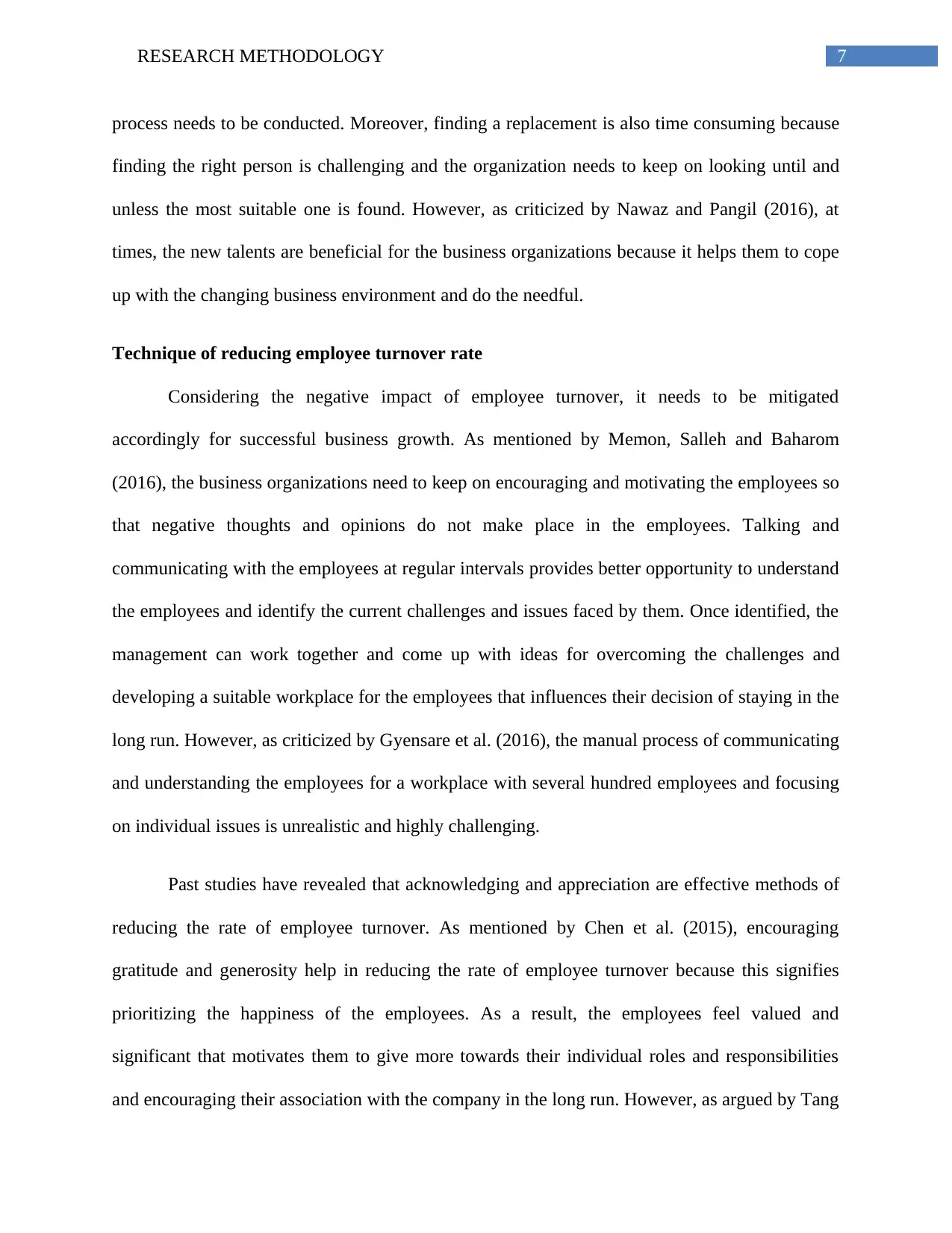
7RESEARCH METHODOLOGY
process needs to be conducted. Moreover, finding a replacement is also time consuming because
finding the right person is challenging and the organization needs to keep on looking until and
unless the most suitable one is found. However, as criticized by Nawaz and Pangil (2016), at
times, the new talents are beneficial for the business organizations because it helps them to cope
up with the changing business environment and do the needful.
Technique of reducing employee turnover rate
Considering the negative impact of employee turnover, it needs to be mitigated
accordingly for successful business growth. As mentioned by Memon, Salleh and Baharom
(2016), the business organizations need to keep on encouraging and motivating the employees so
that negative thoughts and opinions do not make place in the employees. Talking and
communicating with the employees at regular intervals provides better opportunity to understand
the employees and identify the current challenges and issues faced by them. Once identified, the
management can work together and come up with ideas for overcoming the challenges and
developing a suitable workplace for the employees that influences their decision of staying in the
long run. However, as criticized by Gyensare et al. (2016), the manual process of communicating
and understanding the employees for a workplace with several hundred employees and focusing
on individual issues is unrealistic and highly challenging.
Past studies have revealed that acknowledging and appreciation are effective methods of
reducing the rate of employee turnover. As mentioned by Chen et al. (2015), encouraging
gratitude and generosity help in reducing the rate of employee turnover because this signifies
prioritizing the happiness of the employees. As a result, the employees feel valued and
significant that motivates them to give more towards their individual roles and responsibilities
and encouraging their association with the company in the long run. However, as argued by Tang
process needs to be conducted. Moreover, finding a replacement is also time consuming because
finding the right person is challenging and the organization needs to keep on looking until and
unless the most suitable one is found. However, as criticized by Nawaz and Pangil (2016), at
times, the new talents are beneficial for the business organizations because it helps them to cope
up with the changing business environment and do the needful.
Technique of reducing employee turnover rate
Considering the negative impact of employee turnover, it needs to be mitigated
accordingly for successful business growth. As mentioned by Memon, Salleh and Baharom
(2016), the business organizations need to keep on encouraging and motivating the employees so
that negative thoughts and opinions do not make place in the employees. Talking and
communicating with the employees at regular intervals provides better opportunity to understand
the employees and identify the current challenges and issues faced by them. Once identified, the
management can work together and come up with ideas for overcoming the challenges and
developing a suitable workplace for the employees that influences their decision of staying in the
long run. However, as criticized by Gyensare et al. (2016), the manual process of communicating
and understanding the employees for a workplace with several hundred employees and focusing
on individual issues is unrealistic and highly challenging.
Past studies have revealed that acknowledging and appreciation are effective methods of
reducing the rate of employee turnover. As mentioned by Chen et al. (2015), encouraging
gratitude and generosity help in reducing the rate of employee turnover because this signifies
prioritizing the happiness of the employees. As a result, the employees feel valued and
significant that motivates them to give more towards their individual roles and responsibilities
and encouraging their association with the company in the long run. However, as argued by Tang
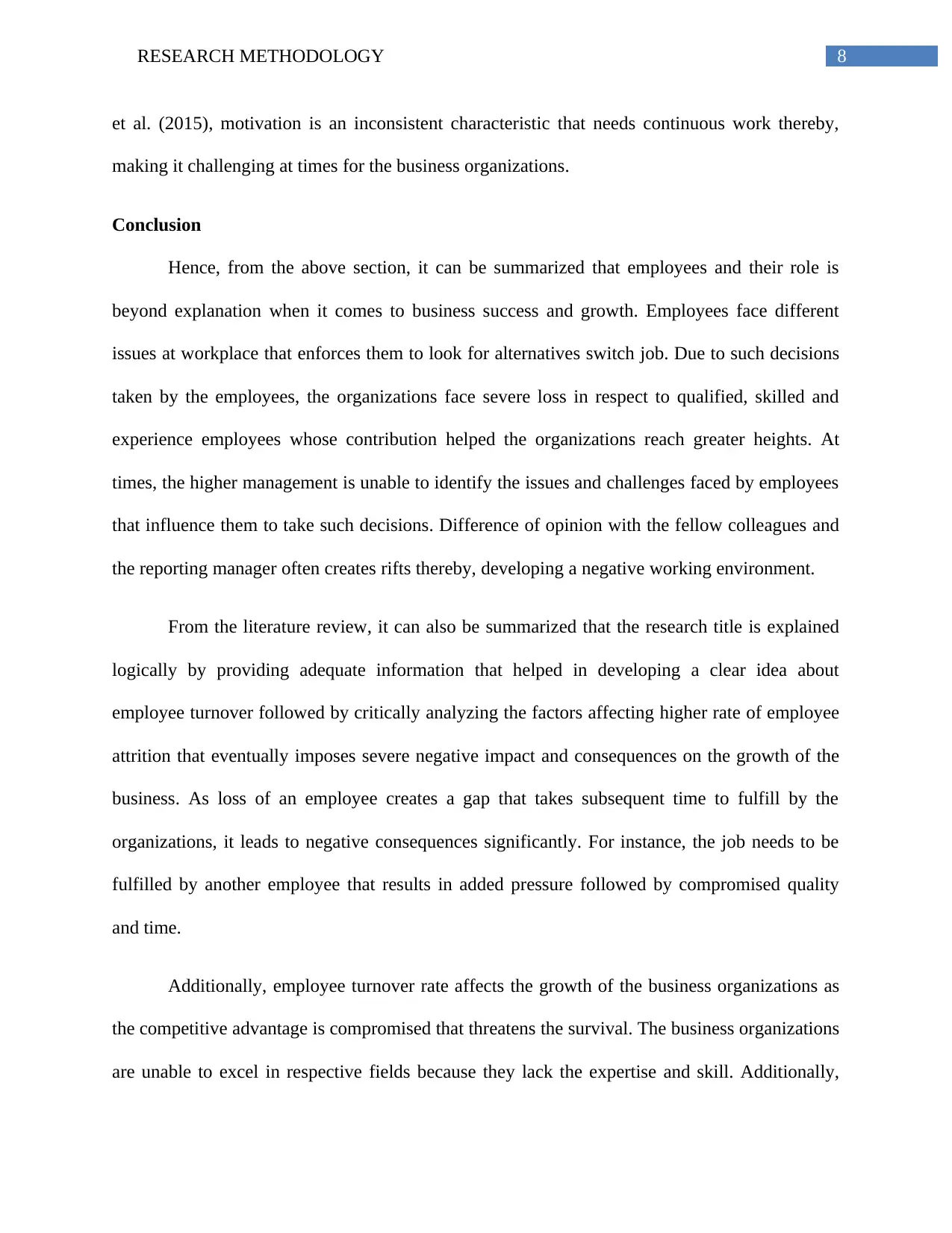
8RESEARCH METHODOLOGY
et al. (2015), motivation is an inconsistent characteristic that needs continuous work thereby,
making it challenging at times for the business organizations.
Conclusion
Hence, from the above section, it can be summarized that employees and their role is
beyond explanation when it comes to business success and growth. Employees face different
issues at workplace that enforces them to look for alternatives switch job. Due to such decisions
taken by the employees, the organizations face severe loss in respect to qualified, skilled and
experience employees whose contribution helped the organizations reach greater heights. At
times, the higher management is unable to identify the issues and challenges faced by employees
that influence them to take such decisions. Difference of opinion with the fellow colleagues and
the reporting manager often creates rifts thereby, developing a negative working environment.
From the literature review, it can also be summarized that the research title is explained
logically by providing adequate information that helped in developing a clear idea about
employee turnover followed by critically analyzing the factors affecting higher rate of employee
attrition that eventually imposes severe negative impact and consequences on the growth of the
business. As loss of an employee creates a gap that takes subsequent time to fulfill by the
organizations, it leads to negative consequences significantly. For instance, the job needs to be
fulfilled by another employee that results in added pressure followed by compromised quality
and time.
Additionally, employee turnover rate affects the growth of the business organizations as
the competitive advantage is compromised that threatens the survival. The business organizations
are unable to excel in respective fields because they lack the expertise and skill. Additionally,
et al. (2015), motivation is an inconsistent characteristic that needs continuous work thereby,
making it challenging at times for the business organizations.
Conclusion
Hence, from the above section, it can be summarized that employees and their role is
beyond explanation when it comes to business success and growth. Employees face different
issues at workplace that enforces them to look for alternatives switch job. Due to such decisions
taken by the employees, the organizations face severe loss in respect to qualified, skilled and
experience employees whose contribution helped the organizations reach greater heights. At
times, the higher management is unable to identify the issues and challenges faced by employees
that influence them to take such decisions. Difference of opinion with the fellow colleagues and
the reporting manager often creates rifts thereby, developing a negative working environment.
From the literature review, it can also be summarized that the research title is explained
logically by providing adequate information that helped in developing a clear idea about
employee turnover followed by critically analyzing the factors affecting higher rate of employee
attrition that eventually imposes severe negative impact and consequences on the growth of the
business. As loss of an employee creates a gap that takes subsequent time to fulfill by the
organizations, it leads to negative consequences significantly. For instance, the job needs to be
fulfilled by another employee that results in added pressure followed by compromised quality
and time.
Additionally, employee turnover rate affects the growth of the business organizations as
the competitive advantage is compromised that threatens the survival. The business organizations
are unable to excel in respective fields because they lack the expertise and skill. Additionally,
⊘ This is a preview!⊘
Do you want full access?
Subscribe today to unlock all pages.

Trusted by 1+ million students worldwide
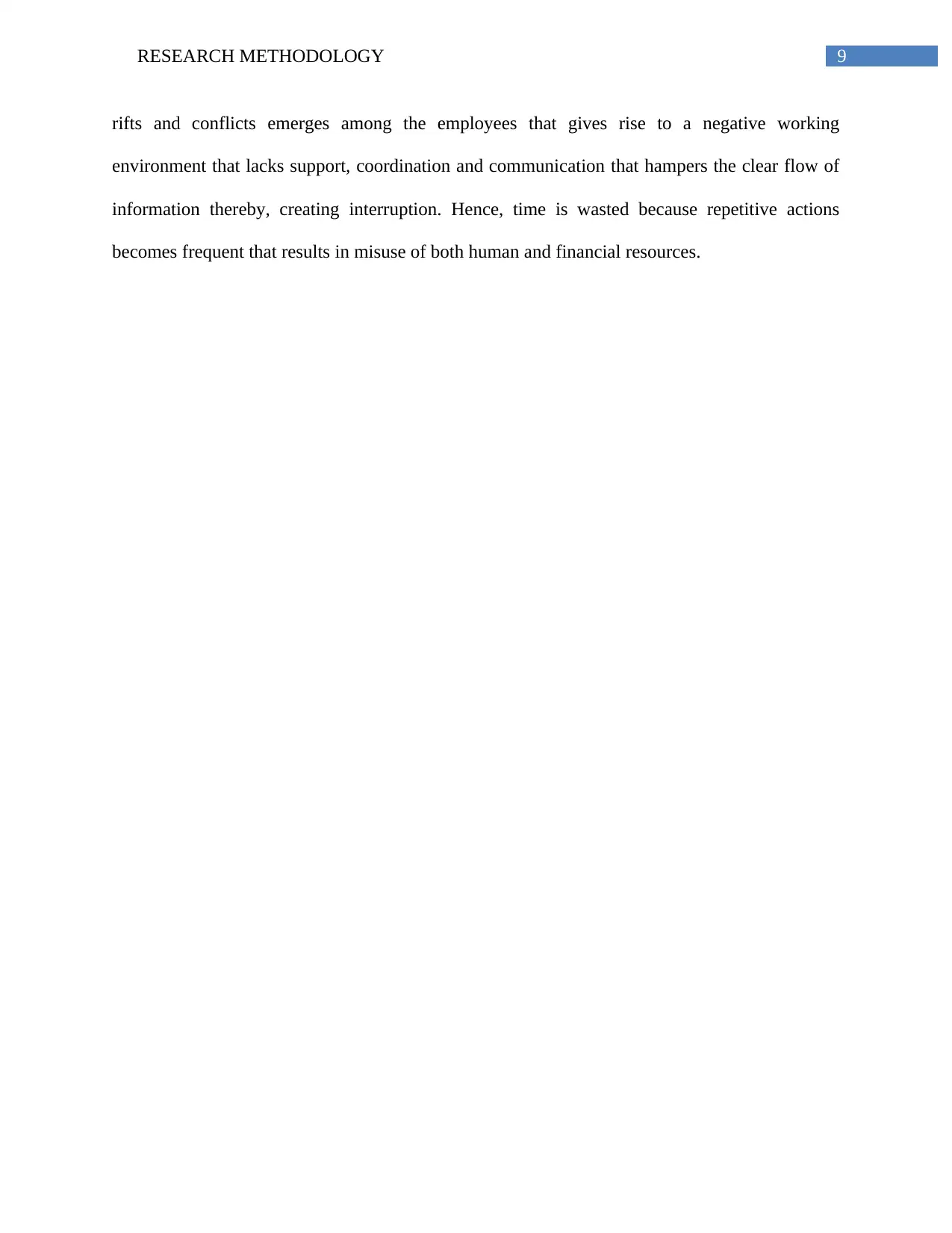
9RESEARCH METHODOLOGY
rifts and conflicts emerges among the employees that gives rise to a negative working
environment that lacks support, coordination and communication that hampers the clear flow of
information thereby, creating interruption. Hence, time is wasted because repetitive actions
becomes frequent that results in misuse of both human and financial resources.
rifts and conflicts emerges among the employees that gives rise to a negative working
environment that lacks support, coordination and communication that hampers the clear flow of
information thereby, creating interruption. Hence, time is wasted because repetitive actions
becomes frequent that results in misuse of both human and financial resources.
Paraphrase This Document
Need a fresh take? Get an instant paraphrase of this document with our AI Paraphraser
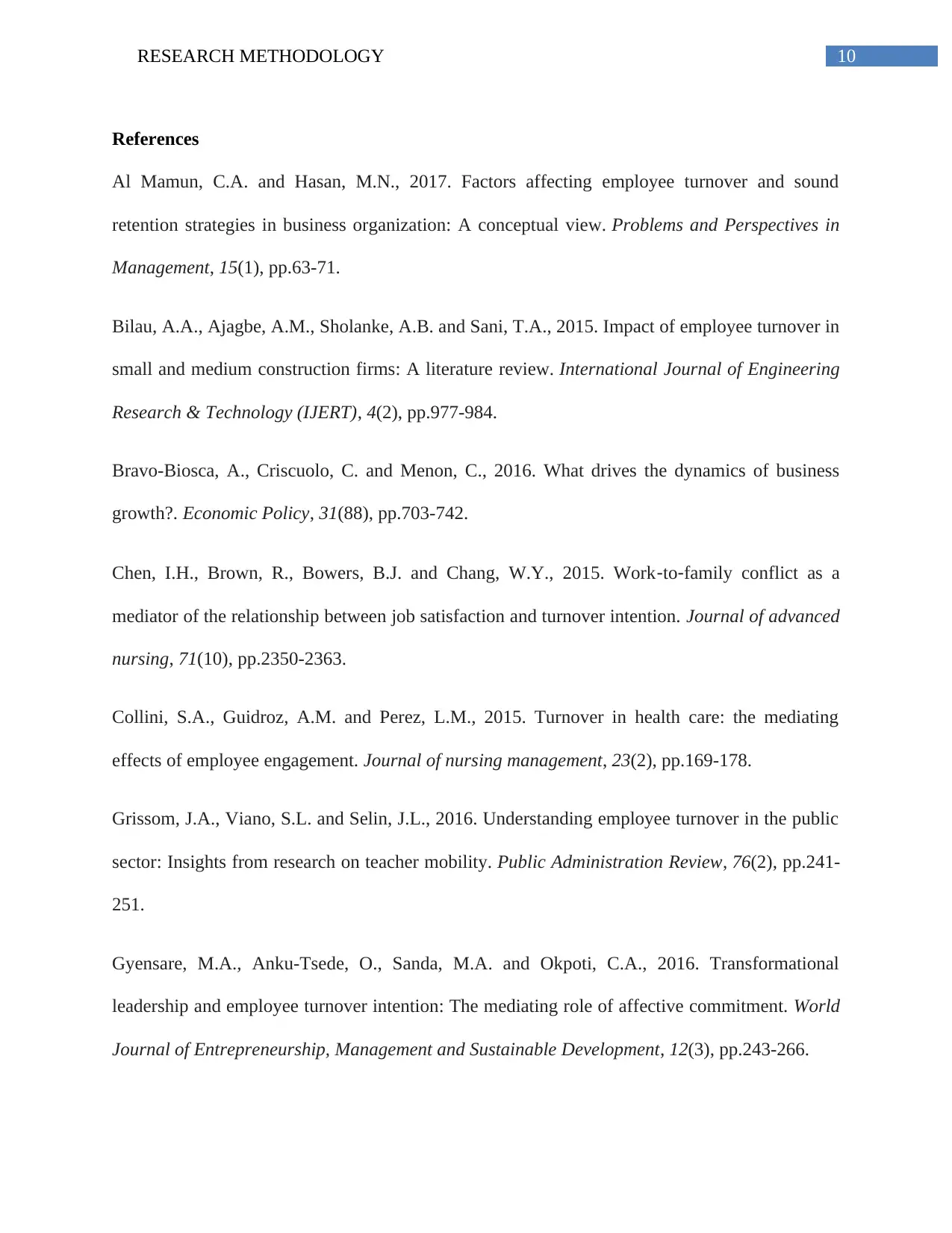
10RESEARCH METHODOLOGY
References
Al Mamun, C.A. and Hasan, M.N., 2017. Factors affecting employee turnover and sound
retention strategies in business organization: A conceptual view. Problems and Perspectives in
Management, 15(1), pp.63-71.
Bilau, A.A., Ajagbe, A.M., Sholanke, A.B. and Sani, T.A., 2015. Impact of employee turnover in
small and medium construction firms: A literature review. International Journal of Engineering
Research & Technology (IJERT), 4(2), pp.977-984.
Bravo-Biosca, A., Criscuolo, C. and Menon, C., 2016. What drives the dynamics of business
growth?. Economic Policy, 31(88), pp.703-742.
Chen, I.H., Brown, R., Bowers, B.J. and Chang, W.Y., 2015. Work‐to‐family conflict as a
mediator of the relationship between job satisfaction and turnover intention. Journal of advanced
nursing, 71(10), pp.2350-2363.
Collini, S.A., Guidroz, A.M. and Perez, L.M., 2015. Turnover in health care: the mediating
effects of employee engagement. Journal of nursing management, 23(2), pp.169-178.
Grissom, J.A., Viano, S.L. and Selin, J.L., 2016. Understanding employee turnover in the public
sector: Insights from research on teacher mobility. Public Administration Review, 76(2), pp.241-
251.
Gyensare, M.A., Anku-Tsede, O., Sanda, M.A. and Okpoti, C.A., 2016. Transformational
leadership and employee turnover intention: The mediating role of affective commitment. World
Journal of Entrepreneurship, Management and Sustainable Development, 12(3), pp.243-266.
References
Al Mamun, C.A. and Hasan, M.N., 2017. Factors affecting employee turnover and sound
retention strategies in business organization: A conceptual view. Problems and Perspectives in
Management, 15(1), pp.63-71.
Bilau, A.A., Ajagbe, A.M., Sholanke, A.B. and Sani, T.A., 2015. Impact of employee turnover in
small and medium construction firms: A literature review. International Journal of Engineering
Research & Technology (IJERT), 4(2), pp.977-984.
Bravo-Biosca, A., Criscuolo, C. and Menon, C., 2016. What drives the dynamics of business
growth?. Economic Policy, 31(88), pp.703-742.
Chen, I.H., Brown, R., Bowers, B.J. and Chang, W.Y., 2015. Work‐to‐family conflict as a
mediator of the relationship between job satisfaction and turnover intention. Journal of advanced
nursing, 71(10), pp.2350-2363.
Collini, S.A., Guidroz, A.M. and Perez, L.M., 2015. Turnover in health care: the mediating
effects of employee engagement. Journal of nursing management, 23(2), pp.169-178.
Grissom, J.A., Viano, S.L. and Selin, J.L., 2016. Understanding employee turnover in the public
sector: Insights from research on teacher mobility. Public Administration Review, 76(2), pp.241-
251.
Gyensare, M.A., Anku-Tsede, O., Sanda, M.A. and Okpoti, C.A., 2016. Transformational
leadership and employee turnover intention: The mediating role of affective commitment. World
Journal of Entrepreneurship, Management and Sustainable Development, 12(3), pp.243-266.
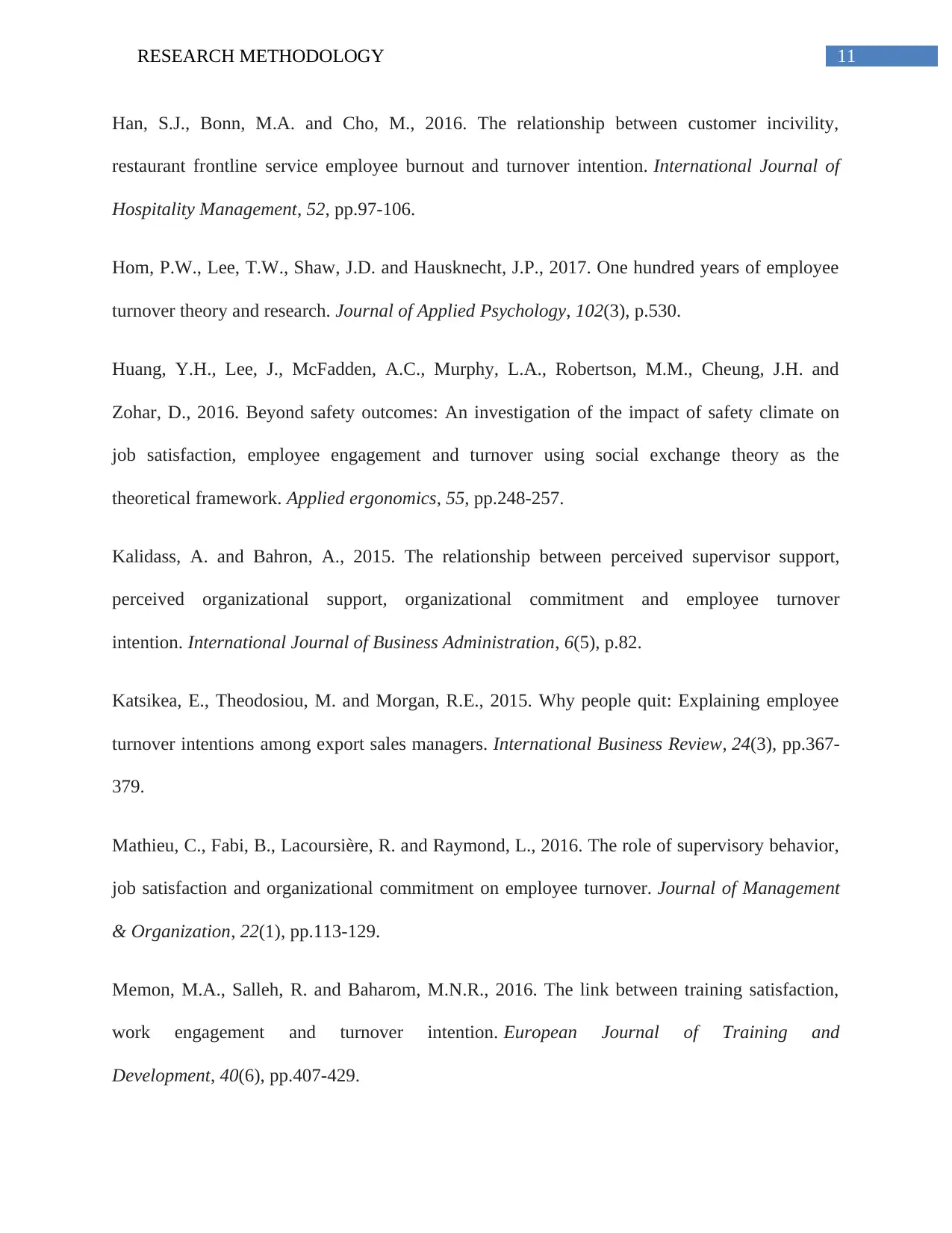
11RESEARCH METHODOLOGY
Han, S.J., Bonn, M.A. and Cho, M., 2016. The relationship between customer incivility,
restaurant frontline service employee burnout and turnover intention. International Journal of
Hospitality Management, 52, pp.97-106.
Hom, P.W., Lee, T.W., Shaw, J.D. and Hausknecht, J.P., 2017. One hundred years of employee
turnover theory and research. Journal of Applied Psychology, 102(3), p.530.
Huang, Y.H., Lee, J., McFadden, A.C., Murphy, L.A., Robertson, M.M., Cheung, J.H. and
Zohar, D., 2016. Beyond safety outcomes: An investigation of the impact of safety climate on
job satisfaction, employee engagement and turnover using social exchange theory as the
theoretical framework. Applied ergonomics, 55, pp.248-257.
Kalidass, A. and Bahron, A., 2015. The relationship between perceived supervisor support,
perceived organizational support, organizational commitment and employee turnover
intention. International Journal of Business Administration, 6(5), p.82.
Katsikea, E., Theodosiou, M. and Morgan, R.E., 2015. Why people quit: Explaining employee
turnover intentions among export sales managers. International Business Review, 24(3), pp.367-
379.
Mathieu, C., Fabi, B., Lacoursière, R. and Raymond, L., 2016. The role of supervisory behavior,
job satisfaction and organizational commitment on employee turnover. Journal of Management
& Organization, 22(1), pp.113-129.
Memon, M.A., Salleh, R. and Baharom, M.N.R., 2016. The link between training satisfaction,
work engagement and turnover intention. European Journal of Training and
Development, 40(6), pp.407-429.
Han, S.J., Bonn, M.A. and Cho, M., 2016. The relationship between customer incivility,
restaurant frontline service employee burnout and turnover intention. International Journal of
Hospitality Management, 52, pp.97-106.
Hom, P.W., Lee, T.W., Shaw, J.D. and Hausknecht, J.P., 2017. One hundred years of employee
turnover theory and research. Journal of Applied Psychology, 102(3), p.530.
Huang, Y.H., Lee, J., McFadden, A.C., Murphy, L.A., Robertson, M.M., Cheung, J.H. and
Zohar, D., 2016. Beyond safety outcomes: An investigation of the impact of safety climate on
job satisfaction, employee engagement and turnover using social exchange theory as the
theoretical framework. Applied ergonomics, 55, pp.248-257.
Kalidass, A. and Bahron, A., 2015. The relationship between perceived supervisor support,
perceived organizational support, organizational commitment and employee turnover
intention. International Journal of Business Administration, 6(5), p.82.
Katsikea, E., Theodosiou, M. and Morgan, R.E., 2015. Why people quit: Explaining employee
turnover intentions among export sales managers. International Business Review, 24(3), pp.367-
379.
Mathieu, C., Fabi, B., Lacoursière, R. and Raymond, L., 2016. The role of supervisory behavior,
job satisfaction and organizational commitment on employee turnover. Journal of Management
& Organization, 22(1), pp.113-129.
Memon, M.A., Salleh, R. and Baharom, M.N.R., 2016. The link between training satisfaction,
work engagement and turnover intention. European Journal of Training and
Development, 40(6), pp.407-429.
⊘ This is a preview!⊘
Do you want full access?
Subscribe today to unlock all pages.

Trusted by 1+ million students worldwide
1 out of 13
Related Documents
Your All-in-One AI-Powered Toolkit for Academic Success.
+13062052269
info@desklib.com
Available 24*7 on WhatsApp / Email
![[object Object]](/_next/static/media/star-bottom.7253800d.svg)
Unlock your academic potential
Copyright © 2020–2025 A2Z Services. All Rights Reserved. Developed and managed by ZUCOL.





